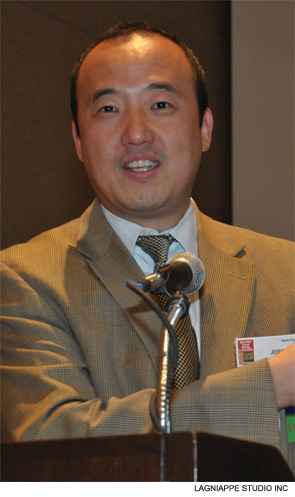San Francisco, Calif.—It is now well recognized that pathogens found in biofilms play a role in many mucosal-based otolaryngologic-related infections, but what that role is and how to prevent or treat biofilms remain unknown, concluded a panel of experts convened here on Sept. 17 at the 2011 American Academy of Otolaryngology-Head and Neck Surgery Annual Meeting.
Explore This Issue
October 2011Emphasizing that a great deal of basic research has now shown the presence of biofilms in areas of the body related to otolaryngologic diseases, David Darrow, MD, DDS, a pediatric otolaryngologist at Eastern Virginia Medical School, Norfolk, Va., said that the task now is to translate that research to the clinic. “The question is, does a biofilm cause a clinical disease,” he said.
Chronic Rhinosinusitis
Although multiple studies have shown that biofilms exist in normal mucosa as well as infected sinuses, and although there are now good tools for detecting biofilms, one of the big unknowns is the point at which a biofilm becomes problematic, according to Joseph K. Han, MD, associate professor and director of allergy, rhinology and endoscopic sinus and skull base surgery at Eastern Virginia Medical School in Norfolk, Va.
“Despite a decade of research on biofilm and sinusitis, we still don’t know when a biofilm becomes pathogenic,” he said, adding that the basic science supports the fact that biofilm in chronic rhinosinusitis (CRS) can cause mucosal injury when the bacteria in the biofilm bind to the epithelium and destroy it through local inflammation.
Whether or not this injury is caused by the amount of biofilm or by the type of organism found on the biofilm is not known. “My personal thought is that the organism and the quantity of the organism allows the biofilm to become pathogenic,” he said.
Dr. Han also addressed the issue of treatment, including the use of topical antibiotics, mechanical disruption and topical surfactant to treat the bacteria on the biofilms directly. Other treatment options may involve treatment of the inflammation, which would not eradicate the biofilm but would decrease the inflammation. He emphasized that a single modal therapy will most likely not be effective to treat biofilms in patients with CRS and that most will need multi-modality treatment that includes high-dose topical antibiotics with a surfactant after mechanical disruption such as endoscopic sinus surgery or hydrodynamic shearing of the biofilm in the sinuses.
Adenoids and Tonsils

According to Dr. Darrow, biofilms are known to be present in the tonsils and adenoids, and early evidence suggests a connection between the presence of pathogens in the biofilms and disease, but whether the pathogens in the biofilms are causing disease remains unclear.
Part of the problem in translating some of the outcomes seen in basic research to the clinic, he said, is that the clinical situation is often different than the one analyzed in the research study.
He cited, for example, the theory proposed by basic research that biofilms in tonsils and adenoids may be a reservoir for bacteria, a condition that results in recurrent and chronic upper respiratory illness. He walked participants through outcomes from studies on otitis media (OM) that looked at the presence of biofilms on the adenoids of children who had undergone adenoidectomy for various conditions. One study showed that for the children with recurrent acute OM, the average adenoid was 98 percent covered with biofilm on its surface, while 28 percent of children with chronic middle ear fluid had biofilms on their adenoids, and less than 1 percent of those who had their adenoids removed because of obstruction alone had biofilms on their adenoids (Am J Otolaryngol. 2010;31(4):241-245).
“The conclusion of these studies was that the children with acute recurrent OM had a much higher likelihood of having pathogens within the biofilm,” he said. “The problem is that when you look at the clinical data, adenoidectomy is actually more effective as adjunct therapy for children with chronic fluid than for children with recurrent OM. So the basic science doesn’t correlate with the clinical situation.”
Another problem with outcomes from research studies is that they include a heterogeneity of patients, making the outcomes difficult to translate into the clinical setting. For example, he said a basic problem with these studies is the criteria used for determining which patients had recurrent acute ear infections. According to Dr. Darrow, these criteria are weak, and clinical studies would require higher standards for patients enrolled in a clinical trial.
Overall, Dr. Darrow emphasized the need for more studies. “We don’t have a lot of data that translates well into the clinical realm telling us whether the biofilms are actually causing disease or not,” he said.
Until more clinically applicable studies are done, Dr. Darrow thinks any discussion of treatment is premature. “Before treating biofilms, we have to prove they cause a problem,” he said, adding that current treatment of biofilms on the adenoids or tonsils requires simply removing them. “If the biofilms are pathogenic, removing these tissues will theoretically fix the problem,” he said.
Otitis Media
Craig Derkay, MD, professor and vice chairman of otolaryngology-head and neck surgery at Eastern Virginia Medical School in Norfolk, Va., who moderated the session, highlighted specific types of pathogens found in biofilms that are associated with OM, in particular Streptococcus pneumoniae.
According to Dr. Derkay, bacteria such as Streptococcus pneumoniae within a biofilm differ from bacteria growing in suspension in many ways, including reduced growth rate, distinct gene expression and increased resistance to antibiotics. He said the difficulty of culturing bacteria in biofilms in the lab, and their resistance to antibiotics, may explain the conflicting features of OM in a patient with symptoms of chronic OM who responds poorly to antibiotics and in whom their culture is negative.
“Since biofilms are resistant to many antibiotics, we suspect that biofilm formation may explain why infections by Streptococcus pneumoniae and other organisms may be so difficult to treat in some children,” he said, adding that new therapies are needed to overcome these hardy infections.
Leave a Reply